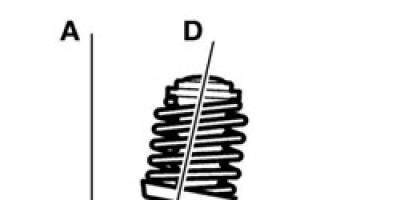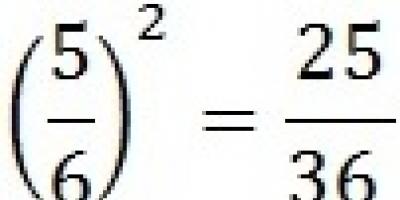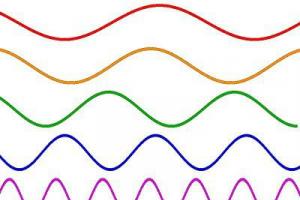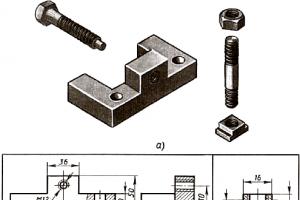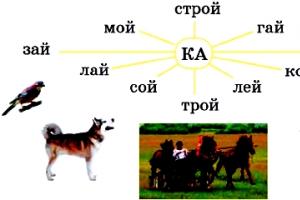The area of a square plot of land is 81 dm². Find his side. Suppose the side length of the square is X decimeters. Then the area of the plot is X² square decimeters. Since, according to the condition, this area is equal to 81 dm², then X² = 81. The length of a side of a square is a positive number. A positive number whose square is 81 is the number 9. When solving the problem, it was necessary to find the number x whose square is 81, i.e. solve the equation X² = 81. This equation has two roots: x 1 = 9 and x 2 = - 9, since 9² = 81 and (- 9)² = 81. Both numbers 9 and - 9 are called the square roots of 81.
Note that one of the square roots X= 9 is a positive number. It is called the arithmetic square root of 81 and is denoted √81, so √81 = 9.
Arithmetic square root of a number A is a non-negative number whose square is equal to A.
For example, the numbers 6 and - 6 are square roots of the number 36. However, the number 6 is an arithmetic square root of 36, since 6 is a non-negative number and 6² = 36. The number - 6 is not an arithmetic root.
Arithmetic square root of a number A denoted as follows: √ A.
The sign is called the arithmetic square root sign; A- called a radical expression. Expression √ A read like this: arithmetic square root of a number A. For example, √36 = 6, √0 = 0, √0.49 = 0.7. In cases where it is clear that we are talking about an arithmetic root, they briefly say: “the square root of A«.
The act of finding the square root of a number is called square rooting. This action is the reverse of squaring.
You can square any number, but you can't extract square roots from any number. For example, it is impossible to extract the square root of the number - 4. If such a root existed, then, denoting it with the letter X, we would get the incorrect equality x² = - 4, since there is a non-negative number on the left and a negative number on the right.
Expression √ A only makes sense when a ≥ 0. The definition of square root can be briefly written as: √ a ≥ 0, (√A)² = A. Equality (√ A)² = A valid for a ≥ 0. Thus, to ensure that the square root of a non-negative number A equals b, i.e. in the fact that √ A =b, you need to check that the following two conditions are met: b ≥ 0, b² = A.
Square root of a fraction
Let's calculate. Note that √25 = 5, √36 = 6, and let’s check whether the equality holds.
Because  and , then the equality is true. So,
and , then the equality is true. So,  .
.
Theorem: If A≥ 0 and b> 0, that is, the root of the fraction is equal to the root of the numerator divided by the root of the denominator. It is required to prove that: and  .
.
Since √ A≥0 and √ b> 0, then .
On the property of raising a fraction to a power and the definition of a square root  the theorem is proven. Let's look at a few examples.
the theorem is proven. Let's look at a few examples.
Calculate using the proven theorem  .
.
Second example: Prove that  , If A ≤ 0, b < 0.
, If A ≤ 0, b < 0.  .
.
Another example: Calculate .
 .
.
Square Root Conversion
Removing the multiplier from under the root sign. Let the expression be given. If A≥ 0 and b≥ 0, then using the product root theorem we can write:
This transformation is called removing the factor from the root sign. Let's look at an example;
Calculate at X= 2. Direct substitution X= 2 in the radical expression leads to complex calculations. These calculations can be simplified if you first remove the factors from under the root sign: . Substituting now x = 2, we get:.
So, when removing the factor from under the root sign, the radical expression is represented in the form of a product in which one or more factors are squares of non-negative numbers. Then apply the product root theorem and take the root of each factor. Let's consider an example: Simplify the expression A = √8 + √18 - 4√2 by taking out the factors in the first two terms from under the root sign, we get:. We emphasize that equality ![]() valid only when A≥ 0 and b≥ 0. if A < 0, то .
valid only when A≥ 0 and b≥ 0. if A < 0, то .
This article is a collection of detailed information that relates to the topic of the properties of roots. Considering the topic, we will start with the properties, study all the formulations and provide evidence. To consolidate the topic, we will consider properties of the nth degree.
Yandex.RTB R-A-339285-1
Properties of roots
We'll talk about properties.
- Property multiplied numbers a And b, which is represented as the equality a · b = a · b. It can be represented in the form of factors, positive or equal to zero a 1 , a 2 , … , a k as a 1 · a 2 · … · a k = a 1 · a 2 · … · a k ;
- from the quotient a: b = a: b, a ≥ 0, b > 0, it can also be written in this form a b = a b;
- Property from the power of a number a with even exponent a 2 m = a m for any number a, for example, the property from the square of a number a 2 = a.
In any of the presented equations, you can swap the parts before and after the dash sign, for example, the equality a · b = a · b is transformed as a · b = a · b. Equality properties are often used to simplify complex equations.
The proof of the first properties is based on the definition of the square root and the properties of powers with a natural exponent. To justify the third property, it is necessary to refer to the definition of the modulus of a number.
First of all, it is necessary to prove the properties of the square root a · b = a · b. According to the definition, it is necessary to consider that a b is a number, positive or equal to zero, which will be equal to a b during construction into a square. The value of the expression a · b is positive or equal to zero as the product of non-negative numbers. The property of powers of multiplied numbers allows us to represent equality in the form (a · b) 2 = a 2 · b 2 . By definition of the square root, a 2 = a and b 2 = b, then a · b = a 2 · b 2 = a · b.
In a similar way one can prove that from the product k multipliers a 1 , a 2 , … , a k will be equal to the product of the square roots of these factors. Indeed, a 1 · a 2 · … · a k 2 = a 1 2 · a 2 2 · … · a k 2 = a 1 · a 2 · … · a k .
From this equality it follows that a 1 · a 2 · … · a k = a 1 · a 2 · … · a k.
Let's look at a few examples to reinforce the topic.
Example 1
3 5 2 5 = 3 5 2 5, 4, 2 13 1 2 = 4, 2 13 1 2 and 2, 7 4 12 17 0, 2 (1) = 2, 7 4 12 17 · 0 , 2 (1) .
It is necessary to prove the property of the arithmetic square root of the quotient: a: b = a: b, a ≥ 0, b > 0. The property allows us to write the equality a: b 2 = a 2: b 2, and a 2: b 2 = a: b, while a: b is a positive number or equal to zero. This expression will become the proof.
For example, 0:16 = 0:16, 80:5 = 80:5 and 30.121 = 30.121.
Let's consider the property of the square root of the square of a number. It can be written as an equality as a 2 = a To prove this property, it is necessary to consider in detail several equalities for a ≥ 0 and at a< 0 .
Obviously, for a ≥ 0 the equality a 2 = a is true. At a< 0 the equality a 2 = - a will be true. In fact, in this case − a > 0 and (− a) 2 = a 2 . We can conclude, a 2 = a, a ≥ 0 - a, a< 0 = a . Именно это и требовалось доказать.
Let's look at a few examples.
Example 2
5 2 = 5 = 5 and - 0.36 2 = - 0.36 = 0.36.
The proven property will help to justify a 2 m = a m, where a– real, and m-natural number. Indeed, the property of raising a power allows us to replace the power a 2 m expression (a m) 2, then a 2 m = (a m) 2 = a m.
Example 3
3 8 = 3 4 = 3 4 and (- 8 , 3) 14 = - 8 , 3 7 = (8 , 3) 7 .
Properties of the nth root
First, we need to consider the basic properties of nth roots:
- Property from the product of numbers a And b, which are positive or equal to zero, can be expressed as the equality a · b n = a n · b n , this property is valid for the product k numbers a 1 , a 2 , … , a k as a 1 · a 2 · … · a k n = a 1 n · a 2 n · … · a k n ;
- from a fractional number has the property a b n = a n b n , where a is any real number that is positive or equal to zero, and b– positive real number;
- For any a and even indicators n = 2 m a 2 · m 2 · m = a is true, and for odd n = 2 m − 1 the equality a 2 · m - 1 2 · m - 1 = a holds.
- Property of extraction from a m n = a n m , where a– any number, positive or equal to zero, n And m are natural numbers, this property can also be represented in the form. . . a n k n 2 n 1 = a n 1 · n 2 . . . · n k ;
- For any non-negative a and arbitrary n And m, which are natural, we can also define the fair equality a m n · m = a n ;
- Property of degree n from the power of a number a, which is positive or equal to zero, to the natural power m, defined by the equality a m n = a n m ;
- Comparison property that have the same exponents: for any positive numbers a And b such that a< b , the inequality a n< b n ;
- Comparison property that have the same numbers under the root: if m And n – natural numbers that m > n, then at 0 < a < 1 the inequality a m > a n is true, and when a > 1 executed a m< a n .
The equalities given above are valid if the parts before and after the equal sign are swapped. They can also be used in this form. This is often used when simplifying or transforming expressions.
The proof of the above properties of a root is based on the definition, properties of the degree and the definition of the modulus of a number. These properties must be proven. But everything is in order.
- First of all, let's prove the properties of the nth root of the product a · b n = a n · b n . For a And b , which are positive or equal to zero , the value a n · b n is also positive or equal to zero, since it is a consequence of multiplying non-negative numbers. The property of a product to the natural power allows us to write the equality a n · b n n = a n n · b n n . By definition of a root n-th degree a n n = a and b n n = b , therefore, a n · b n n = a · b . The resulting equality is exactly what needed to be proven.
This property can be proved similarly for the product k multipliers: for non-negative numbers a 1, a 2, …, a n, a 1 n · a 2 n · … · a k n ≥ 0.
Here are examples of using the root property n-th power from the product: 5 2 1 2 7 = 5 7 2 1 2 7 and 8, 3 4 17, (21) 4 3 4 5 7 4 = 8, 3 17, (21) 3 · 5 7 4 .
- Let us prove the property of the root of the quotient a b n = a n b n . At a ≥ 0 And b > 0 the condition a n b n ≥ 0 is satisfied, and a n b n n = a n n b n n = a b .
Let's show examples:
Example 4
8 27 3 = 8 3 27 3 and 2, 3 10: 2 3 10 = 2, 3: 2 3 10.
- For the next step it is necessary to prove the properties of the nth degree from the number to the degree n. Let's imagine this as the equality a 2 m 2 m = a and a 2 m - 1 2 m - 1 = a for any real a and natural m. At a ≥ 0 we get a = a and a 2 m = a 2 m, which proves the equality a 2 m 2 m = a, and the equality a 2 m - 1 2 m - 1 = a is obvious. At a< 0 we obtain, respectively, a = - a and a 2 m = (- a) 2 m = a 2 m. The last transformation of a number is valid according to the power property. This is precisely what proves the equality a 2 m 2 m = a, and a 2 m - 1 2 m - 1 = a will be true, since the odd degree is considered - c 2 m - 1 = - c 2 m - 1 for any number c , positive or equal to zero.
In order to consolidate the information received, let's consider several examples using the property:
Example 5
7 4 4 = 7 = 7, (- 5) 12 12 = - 5 = 5, 0 8 8 = 0 = 0, 6 3 3 = 6 and (- 3, 39) 5 5 = - 3, 39.
- Let us prove the following equality a m n = a n m . To do this, you need to swap the numbers before and after the equal sign a n · m = a m n . This will mean the entry is correct. For a, which is positive or equal to zero , of the form a m n is a number positive or equal to zero. Let us turn to the property of raising a power to a power and its definition. With their help, you can transform equalities in the form a m n n · m = a m n n m = a m m = a. This proves the property of the root of the root under consideration.
Other properties are proved similarly. Really, . . . a n k n 2 n 1 n 1 · n 2 · . . . · n k = . . . a n k n 3 n 2 n 2 · n 3 · . . . · n k = . . . a n k n 4 n 3 n 3 · n 4 · . . . · n k = . . . = a n k n k = a .
For example, 7 3 5 = 7 5 3 and 0.0009 6 = 0.0009 2 2 6 = 0.0009 24.
- Let us prove the following property a m n · m = a n . To do this, it is necessary to show that a n is a number, positive or equal to zero. When raised to the power n m is equal to a m. If the number a is positive or equal to zero, then n-th degree from among a is a positive number or equal to zero. In this case, a n · m n = a n n m , which is what needed to be proved.
In order to consolidate the knowledge gained, let's look at a few examples.
- Let us prove the following property – the property of a root of a power of the form a m n = a n m . It is obvious that when a ≥ 0 the degree a n m is a non-negative number. Moreover, her n the th power is equal to a m, indeed, a n m n = a n m · n = a n n m = a m . This proves the property of the degree under consideration.
For example, 2 3 5 3 = 2 3 3 5.
- It is necessary to prove that for any positive numbers a and b the condition is satisfied a< b . Consider the inequality a n< b n . Воспользуемся методом от противного a n ≥ b n . Тогда, согласно свойству, о котором говорилось выше, неравенство считается верным a n n ≥ b n n , то есть, a ≥ b . Но это не соответствует условию a< b . Therefore, a n< b n при a< b .
For example, let's give 12 4< 15 2 3 4 .
- Consider the property of the root n-th degree. It is necessary to first consider the first part of the inequality. At m > n And 0 < a < 1 true a m > a n . Let's assume that a m ≤ a n. The properties will allow you to simplify the expression to a n m · n ≤ a m m · n . Then, according to the properties of a degree with a natural exponent, the inequality a n m · n m · n ≤ a m m · n m · n holds, that is, a n ≤ a m. The obtained value at m > n And 0 < a < 1 does not correspond to the properties given above.
In the same way it can be proven that when m > n And a > 1 the condition a m is true< a n .
In order to consolidate the above properties, let's consider several specific examples. Let's look at inequalities using specific numbers.
Example 6
0 , 7 3 < 0 , 7 5 и 12 > 12 7 .
If you notice an error in the text, please highlight it and press Ctrl+Enter
A radical expression is an algebraic expression that is under the sign of a root (square, cubic, or higher order). Sometimes the meanings of different expressions can be the same, for example, 1/(√2 - 1) = √2 + 1. Simplification of the radical expression is intended to bring it to some canonical form of notation. If two expressions that are written in canonical form are still different, their values are not equal. In mathematics, it is believed that the canonical form of writing radical expressions (as well as expressions with roots) corresponds to the following rules:
- If possible, get rid of the fraction under the root sign
- Get rid of expressions with fractional exponents
- If possible, get rid of the roots in the denominator
- Get rid of the root-by-root multiplication operation
- Under the root sign, you need to leave only those terms from which it is impossible to extract an integer root
These rules can be applied to test tasks. For example, if you solved a problem, but the result does not match any of the answers given, write the result in canonical form. Keep in mind that answers to test tasks are given in canonical form, so if you write the result in the same form, you can easily determine the correct answer. If a problem requires “simplifying the answer” or “simplifying radical expressions,” it is necessary to write the result in canonical form. Moreover, the canonical form makes solving equations easier, although some equations are easier to solve if you forget about the canonical notation for a while.
Steps
Getting rid of full squares and full cubes
Getting rid of an expression with a fractional exponent
Convert the expression with a fractional exponent into a radical expression. Or, if necessary, convert the radical expression into a fractional expression, but never mix such expressions in one equation, for example, like this: √5 + 5^(3/2). Let's say you decide to work with the roots; We will denote the square root of n as √n, and the cubic root of n as the cube√n.
Getting rid of fractions under the root sign
According to the canonical form of notation, the root of a fraction must be represented as a division of the roots of integers.
- Do not use this identity if the denominator is negative or includes a variable that may be negative. In this case, simplify the fraction first.
-
Simplify the perfect squares (if you have them). For example, √(5/4) = √5/√4 = (√5)/2.
Look at the radical expression. If it is a fraction, go to the next step.
Replace the root of the fraction with the ratio of the two roots according to the following identity:√(a/b) = √a/√b.
Eliminating the operation of multiplying roots
Getting rid of factors that are perfect squares
- For example, write down all the factors of 45: 1, 3, 5, 9, 15, 45. 9 is a factor of 45 (9 x 5 = 45) and a perfect square (9 = 3^2).
-
Take the multiplier, which is a perfect square, beyond the root sign. 9 is a perfect square because 3 x 3 = 9. Get rid of the 9 under the root sign and write a 3 before the root sign; under the root sign there will be 5. If you put the number 3 under the root sign, it will be multiplied by itself and by the number 5, that is, 3 x 3 x 5 = 9 x 5 = 45. Thus, 3√ 5 is a simplified form of notation √45.
- √45 = √(9 * 5) = √9 * √5 = 3√5.
-
Find the perfect square in the radical expression with the variable. Remember: √(a^2) = |a|. Such an expression can be simplified to "a", but only if the variable takes positive values. √(a^3) can be decomposed into √a * √(a^2), because when identical variables are multiplied, their exponents add up (a * a^2 = a^3).
- Thus, in the expression a^3, the perfect square is a^2.
-
Take out the variable that is a perfect square outside the root sign. Get rid of the a^2 under the root sign and write an "a" before the root sign. Thus, √(a^3) = a√a.
Give similar terms and simplify any rational expressions.
Lay out radical number into factors. Factors are some numbers that, when multiplied, produce the original number. For example, 5 and 4 are two factors of the number 20. If an integer root cannot be extracted from a radical number, factor the number into its possible factors and find a perfect square among them.
Getting rid of roots in the denominator (rationalization of the denominator)
- If the denominator is a radical monomial, such as [numerator]/√5, multiply the numerator and denominator by that root: ([numerator] * √5)/(√5 * √5) = ([numerator] * √5 )/5.
- For a cube root or greater root, multiply the numerator and denominator by the root with the radical to the appropriate power to rationalize the denominator. If, for example, the denominator is the cube of √5, multiply the numerator and denominator by the cube of √(5^2).
- If the denominator is a sum or difference of square roots, such as √2 + √6, multiply the numerator and denominator by the conjugate, that is, the expression with the opposite sign between its terms. For example: [numerator]/(√2 + √6) = ([numerator] * (√2 - √6))/((√2 + √6) * (√2 - √6)). Then use the difference of squares formula ((a + b)(a - b) = a^2 - b^2) to rationalize the denominator: (√2 + √6)(√2 - √6) = (√2)^2 - (√6)^2 = 2 - 6 = -4.
- The difference of squares formula can also be applied to an expression of the form 5 + √3 because any integer is the square root of another integer. For example: 1/(5 + √3) = (5 - √3)/((5 + √3)(5 - √3)) = (5 - √3)/(5^2 - (√3)^ 2) = (5 - √3)/(25 - 3) = (5 - √3)/22
- This method can be applied to the sum of square roots such as √5 - √6 + √7. If you group this expression in the form (√5 - √6) + √7 and multiply it by (√5 - √6) - √7, you will not get rid of the roots, but will get an expression of the form a + b * √30, where " a" and "b" are monomials without a root. Then the resulting expression can be multiplied by its conjugate: (a + b * √30)(a - b * √30) to get rid of the roots. That is, if a conjugate expression can be used once to get rid of a certain number of roots, then it can be used as many times as necessary to get rid of all the roots.
- This method also applies to roots of higher powers, such as the expression "4th root of 3 plus 7th root of 9." In this case, multiply the numerator and denominator by the conjugate expression of the denominator. But here the conjugate expression will be slightly different compared to those described above. You can read about this case in algebra textbooks.
-
Simplify the numerator after you have removed the roots in the denominator. The numerator is the product of the original expression and the conjugate expression.
According to the canonical form denominator, if possible, should include only integers (or a polynomial if a variable is present).
Root formulas. Properties of square roots.
Attention!
There are additional
materials in Special Section 555.
For those who are very "not very..."
And for those who “very much…”)
In the previous lesson we figured out what a square root is. It's time to figure out which ones exist formulas for roots what are properties of roots, and what can be done with all this.
Formulas of roots, properties of roots and rules for working with roots- this is essentially the same thing. There are surprisingly few formulas for square roots. Which certainly makes me happy! Or rather, you can write a lot of different formulas, but for practical and confident work with roots, only three are enough. Everything else flows from these three. Although many people get confused in the three root formulas, yes...
Let's start with the simplest one. Here she is:
If you like this site...
By the way, I have a couple more interesting sites for you.)
You can practice solving examples and find out your level. Testing with instant verification. Let's learn - with interest!)
You can get acquainted with functions and derivatives.
Fact 1.
\(\bullet\) Let's take some non-negative number \(a\) (that is, \(a\geqslant 0\) ). Then (arithmetic) square root from the number \(a\) is called such a non-negative number \(b\) , when squared we get the number \(a\) : \[\sqrt a=b\quad \text(same as )\quad a=b^2\] From the definition it follows that \(a\geqslant 0, b\geqslant 0\). These restrictions are an important condition for the existence of a square root and should be remembered!
Recall that any number when squared gives a non-negative result. That is, \(100^2=10000\geqslant 0\) and \((-100)^2=10000\geqslant 0\) .
\(\bullet\) What is \(\sqrt(25)\) equal to? We know that \(5^2=25\) and \((-5)^2=25\) . Since by definition we must find a non-negative number, then \(-5\) is not suitable, therefore, \(\sqrt(25)=5\) (since \(25=5^2\) ).
Finding the value of \(\sqrt a\) is called taking the square root of the number \(a\) , and the number \(a\) is called the radical expression.
\(\bullet\) Based on the definition, expression \(\sqrt(-25)\), \(\sqrt(-4)\), etc. don't make sense.
Fact 2.
For quick calculations, it will be useful to learn the table of squares of natural numbers from \(1\) to \(20\) : \[\begin(array)(|ll|) \hline 1^2=1 & \quad11^2=121 \\ 2^2=4 & \quad12^2=144\\ 3^2=9 & \quad13 ^2=169\\ 4^2=16 & \quad14^2=196\\ 5^2=25 & \quad15^2=225\\ 6^2=36 & \quad16^2=256\\ 7^ 2=49 & \quad17^2=289\\ 8^2=64 & \quad18^2=324\\ 9^2=81 & \quad19^2=361\\ 10^2=100& \quad20^2= 400\\ \hline \end(array)\]
Fact 3.
What operations can you do with square roots?
\(\bullet\) The sum or difference of square roots IS NOT EQUAL to the square root of the sum or difference, that is \[\sqrt a\pm\sqrt b\ne \sqrt(a\pm b)\] Thus, if you need to calculate, for example, \(\sqrt(25)+\sqrt(49)\) , then initially you must find the values of \(\sqrt(25)\) and \(\sqrt(49)\ ) and then fold them. Hence, \[\sqrt(25)+\sqrt(49)=5+7=12\] If the values \(\sqrt a\) or \(\sqrt b\) cannot be found when adding \(\sqrt a+\sqrt b\), then such an expression is not transformed further and remains as it is. For example, in the sum \(\sqrt 2+ \sqrt (49)\) we can find \(\sqrt(49)\) is \(7\) , but \(\sqrt 2\) cannot be transformed in any way, That's why \(\sqrt 2+\sqrt(49)=\sqrt 2+7\). Unfortunately, this expression cannot be simplified further\(\bullet\) The product/quotient of square roots is equal to the square root of the product/quotient, that is \[\sqrt a\cdot \sqrt b=\sqrt(ab)\quad \text(s)\quad \sqrt a:\sqrt b=\sqrt(a:b)\] (provided that both sides of the equalities make sense)
Example: \(\sqrt(32)\cdot \sqrt 2=\sqrt(32\cdot 2)=\sqrt(64)=8\);
\(\sqrt(768):\sqrt3=\sqrt(768:3)=\sqrt(256)=16\);
\(\sqrt((-25)\cdot (-64))=\sqrt(25\cdot 64)=\sqrt(25)\cdot \sqrt(64)= 5\cdot 8=40\). \(\bullet\) Using these properties, it is convenient to find square roots of large numbers by factoring them.
Let's look at an example. Let's find \(\sqrt(44100)\) . Since \(44100:100=441\) , then \(44100=100\cdot 441\) . According to the criterion of divisibility, the number \(441\) is divisible by \(9\) (since the sum of its digits is 9 and is divisible by 9), therefore, \(441:9=49\), that is, \(441=9\ cdot 49\) .
Thus we got: \[\sqrt(44100)=\sqrt(9\cdot 49\cdot 100)= \sqrt9\cdot \sqrt(49)\cdot \sqrt(100)=3\cdot 7\cdot 10=210\] Let's look at another example: \[\sqrt(\dfrac(32\cdot 294)(27))= \sqrt(\dfrac(16\cdot 2\cdot 3\cdot 49\cdot 2)(9\cdot 3))= \sqrt( \ dfrac(16\cdot4\cdot49)(9))=\dfrac(\sqrt(16)\cdot \sqrt4 \cdot \sqrt(49))(\sqrt9)=\dfrac(4\cdot 2\cdot 7)3 =\dfrac(56)3\]
\(\bullet\) Let's show how to enter numbers under the square root sign using the example of the expression \(5\sqrt2\) (short notation for the expression \(5\cdot \sqrt2\)). Since \(5=\sqrt(25)\) , then \
Note also that, for example,
1) \(\sqrt2+3\sqrt2=4\sqrt2\) ,
2) \(5\sqrt3-\sqrt3=4\sqrt3\)
3) \(\sqrt a+\sqrt a=2\sqrt a\) .
Why is that? Let's explain using example 1). As you already understand, we cannot somehow transform the number \(\sqrt2\). Let's imagine that \(\sqrt2\) is some number \(a\) . Accordingly, the expression \(\sqrt2+3\sqrt2\) is nothing more than \(a+3a\) (one number \(a\) plus three more of the same numbers \(a\)). And we know that this is equal to four such numbers \(a\) , that is, \(4\sqrt2\) .
Fact 4.
\(\bullet\) They often say “you can’t extract the root” when you can’t get rid of the sign \(\sqrt () \ \) of the root (radical) when finding the value of a number. For example, you can take the root of the number \(16\) because \(16=4^2\) , therefore \(\sqrt(16)=4\) . But it is impossible to extract the root of the number \(3\), that is, to find \(\sqrt3\), because there is no number that squared will give \(3\) .
Such numbers (or expressions with such numbers) are irrational. For example, numbers \(\sqrt3, \ 1+\sqrt2, \ \sqrt(15)\) and so on. are irrational.
Also irrational are the numbers \(\pi\) (the number “pi”, approximately equal to \(3.14\)), \(e\) (this number is called the Euler number, it is approximately equal to \(2.7\)) etc.
\(\bullet\) Please note that any number will be either rational or irrational. And together all rational and all irrational numbers form a set called a set of real numbers. This set is denoted by the letter \(\mathbb(R)\) .
This means that all the numbers that we currently know are called real numbers.
Fact 5.
\(\bullet\) The modulus of a real number \(a\) is a non-negative number \(|a|\) equal to the distance from the point \(a\) to \(0\) on the real line. For example, \(|3|\) and \(|-3|\) are equal to 3, since the distances from the points \(3\) and \(-3\) to \(0\) are the same and equal to \(3 \) .
\(\bullet\) If \(a\) is a non-negative number, then \(|a|=a\) .
Example: \(|5|=5\) ; \(\qquad |\sqrt2|=\sqrt2\) . \(\bullet\) If \(a\) is a negative number, then \(|a|=-a\) .
Example: \(|-5|=-(-5)=5\) ; \(\qquad |-\sqrt3|=-(-\sqrt3)=\sqrt3\).
They say that for negative numbers the modulus “eats” the minus, while positive numbers, as well as the number \(0\), are left unchanged by the modulus.
BUT This rule only applies to numbers. If under your modulus sign there is an unknown \(x\) (or some other unknown), for example, \(|x|\) , about which we do not know whether it is positive, zero or negative, then get rid of the modulus we can not. In this case, this expression remains the same: \(|x|\) . \(\bullet\) The following formulas hold: \[(\large(\sqrt(a^2)=|a|))\] \[(\large((\sqrt(a))^2=a)), \text( provided ) a\geqslant 0\] Very often the following mistake is made: they say that \(\sqrt(a^2)\) and \((\sqrt a)^2\) are one and the same. This is only true if \(a\) is a positive number or zero. But if \(a\) is a negative number, then this is false. It is enough to consider this example. Let's take instead of \(a\) the number \(-1\) . Then \(\sqrt((-1)^2)=\sqrt(1)=1\) , but the expression \((\sqrt (-1))^2\) does not exist at all (after all, it is impossible to use the root sign put negative numbers!).
Therefore, we draw your attention to the fact that \(\sqrt(a^2)\) is not equal to \((\sqrt a)^2\) ! Example: 1) \(\sqrt(\left(-\sqrt2\right)^2)=|-\sqrt2|=\sqrt2\), because \(-\sqrt2<0\)
;
\(\phantom(00000)\) 2) \((\sqrt(2))^2=2\) . \(\bullet\) Since \(\sqrt(a^2)=|a|\) , then \[\sqrt(a^(2n))=|a^n|\] (the expression \(2n\) denotes an even number)
That is, when taking the root of a number that is to some degree, this degree is halved.
Example:
1) \(\sqrt(4^6)=|4^3|=4^3=64\)
2) \(\sqrt((-25)^2)=|-25|=25\) (note that if the module is not supplied, it turns out that the root of the number is equal to \(-25\) ; but we remember , that by definition of a root this cannot happen: when extracting a root, we should always get a positive number or zero)
3) \(\sqrt(x^(16))=|x^8|=x^8\) (since any number to an even power is non-negative)
Fact 6.
How to compare two square roots?
\(\bullet\) For square roots it is true: if \(\sqrt a<\sqrt b\)
, то \(a
1) compare \(\sqrt(50)\) and \(6\sqrt2\) . First, let's transform the second expression into \(\sqrt(36)\cdot \sqrt2=\sqrt(36\cdot 2)=\sqrt(72)\). Thus, since \(50<72\)
, то и \(\sqrt{50}<\sqrt{72}\)
. Следовательно, \(\sqrt{50}<6\sqrt2\)
.
2) Between what integers is \(\sqrt(50)\) located?
Since \(\sqrt(49)=7\) , \(\sqrt(64)=8\) , and \(49<50<64\)
, то \(7<\sqrt{50}<8\)
, то есть число \(\sqrt{50}\)
находится между числами \(7\)
и \(8\)
.
3) Let's compare \(\sqrt 2-1\) and \(0.5\) . Let's assume that \(\sqrt2-1>0.5\) : \[\begin(aligned) &\sqrt 2-1>0.5 \ \big| +1\quad \text((add one to both sides))\\ &\sqrt2>0.5+1 \ \big| \ ^2 \quad\text((squaring both sides))\\ &2>1.5^2\\ &2>2.25 \end(aligned)\] We see that we have obtained an incorrect inequality. Therefore, our assumption was incorrect and \(\sqrt 2-1<0,5\)
.
Note that adding a certain number to both sides of the inequality does not affect its sign. Multiplying/dividing both sides of an inequality by a positive number also does not affect its sign, but multiplying/dividing by a negative number reverses the sign of the inequality!
You can square both sides of an equation/inequality ONLY IF both sides are non-negative. For example, in the inequality from the previous example you can square both sides, in the inequality \(-3<\sqrt2\)
нельзя (убедитесь в этом сами)!
\(\bullet\) It should be remembered that \[\begin(aligned) &\sqrt 2\approx 1.4\\ &\sqrt 3\approx 1.7 \end(aligned)\] Knowing the approximate meaning of these numbers will help you when comparing numbers! \(\bullet\) In order to extract the root (if it can be extracted) from some large number that is not in the table of squares, you must first determine between which “hundreds” it is located, then – between which “tens”, and then determine the last digit of this number. Let's show how this works with an example.
Let's take \(\sqrt(28224)\) . We know that \(100^2=10\,000\), \(200^2=40\,000\), etc. Note that \(28224\) is between \(10\,000\) and \(40\,000\) . Therefore, \(\sqrt(28224)\) is between \(100\) and \(200\) .
Now let’s determine between which “tens” our number is located (that is, for example, between \(120\) and \(130\)). Also from the table of squares we know that \(11^2=121\) , \(12^2=144\) etc., then \(110^2=12100\) , \(120^2=14400 \) , \(130^2=16900\) , \(140^2=19600\) , \(150^2=22500\) , \(160^2=25600\) , \(170^2=28900 \) . So we see that \(28224\) is between \(160^2\) and \(170^2\) . Therefore, the number \(\sqrt(28224)\) is between \(160\) and \(170\) .
Let's try to determine the last digit. Let's remember what single-digit numbers, when squared, give \(4\) at the end? These are \(2^2\) and \(8^2\) . Therefore, \(\sqrt(28224)\) will end in either 2 or 8. Let's check this. Let's find \(162^2\) and \(168^2\) :
\(162^2=162\cdot 162=26224\)
\(168^2=168\cdot 168=28224\) .
Therefore, \(\sqrt(28224)=168\) . Voila!
In order to adequately solve the Unified State Exam in mathematics, you first need to study theoretical material, which introduces you to numerous theorems, formulas, algorithms, etc. At first glance, it may seem that this is quite simple. However, finding a source in which the theory for the Unified State Exam in mathematics is presented in an easy and understandable way for students with any level of training is in fact a rather difficult task. School textbooks cannot always be kept at hand. And finding basic formulas for the Unified State Exam in mathematics can be difficult even on the Internet.
Why is it so important to study theory in mathematics not only for those taking the Unified State Exam?
- Because it broadens your horizons. Studying theoretical material in mathematics is useful for anyone who wants to get answers to a wide range of questions related to knowledge of the world around them. Everything in nature is ordered and has a clear logic. This is precisely what is reflected in science, through which it is possible to understand the world.
- Because it develops intelligence. By studying reference materials for the Unified State Exam in mathematics, as well as solving various problems, a person learns to think and reason logically, to formulate thoughts competently and clearly. He develops the ability to analyze, generalize, and draw conclusions.
We invite you to personally evaluate all the advantages of our approach to systematization and presentation of educational materials.

